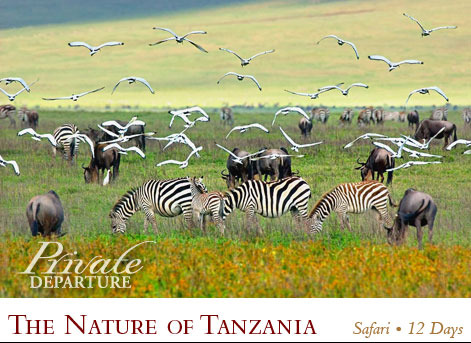The Nature of Tanzania
- Kilimanjaro Airport, Arusha, Tanzania
- Active & Adventure

| from $12,515* per person | 12 Days | Year-round |
| Luxury accommodations | Exertion level: 4 | |
| Operator: Geographic Expeditions | 18 people max | |
Flying into the northern town of Arusha, we have a night to recover from jet lag, then we’re off to Tarangire National Park and Swala Tarangire, a welcoming and uniquely beautiful spot where our chalets are surrounded by baobab trees. From there we’re whisked off to the quintessential Lost World of the Ngorongoro Crater. Our lodge is perched on the crater rim, with breath-stopping views of the caldera’s 100-squaremile floor, rich with nearly every prominent East African species. Then, we begin our exploration of the fascinating Serengeti National Park. To the Maasai, it is Siringutu, “the place where the land moves on forever.” Our tented camps here gives us an authentic taste of safari life, which the great H. M. Stanley extolled as “the sweet and novel pleasure of indifference to all things earthly outside camp, which is one of the most exquisite and soul-lulling pleasures a mortal can enjoy.”
Loading map, please wait...
Locations visited/nearby
Tanzania, Africa
Itinerary
Day 1: arrive in Arusha •Day 2: drive to Lake Manyara National Park, Manyara Tree Lodge •
Day 3: Lake Manyara National Park, Manyara Tree Lodge •
Day 4: drive to the Ngorongoro Crater, Ngorongoro Crater Lodge •
Day 5: Ngorongoro Crater, Ngorongoro Crater Lodge •
Day 6: fly to the northern Serengeti, Sayari •
Days 7 & 8: Serengeti National Park, Sayari •
Day 9: fly to Grumeti Reserves, Sabora •
Days 10-11: Grumeti Reserves, central Serengeti, Sabora •
Day 12: fly to Kilimanjaro Airport, then onward.
More information from Geographic Expeditions:
- View trip on provider's website
www.geoex.com/trips/tanzania-nature… - Company profile, experience, and history
- View all of their trips
- Email this trip page to a friend
-



Comments from Facebook